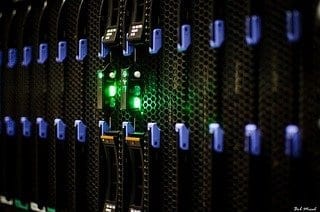New system could reduce data-transmission delays across server farms by 99.6 percent
Big websites usually maintain their own “data centers,” banks of tens or even hundreds of thousands of servers, all passing data back and forth to field users’ requests. Like any big, decentralized network, data centers are prone to congestion: Packets of data arriving at the same router at the same time are put in a queue, and if the queues get too long, packets can be delayed.
At the annual conference of the ACM Special Interest Group on Data Communication, in August, MIT researchers will present a new network-management system that, in experiments, reduced the average queue length of routers in a Facebook data center by 99.6 percent — virtually doing away with queues. When network traffic was heavy, the average latency — the delay between the request for an item of information and its arrival — shrank nearly as much, from 3.56 microseconds to 0.23 microseconds.
Like the Internet, most data centers use decentralized communication protocols: Each node in the network decides, based on its own limited observations, how rapidly to send data and which adjacent node to send it to. Decentralized protocols have the advantage of an ability to handle communication over large networks with little administrative oversight.
The MIT system, dubbed Fastpass, instead relies on a central server called an “arbiter” to decide which nodes in the network may send data to which others during which periods of time. “It’s not obvious that this is a good idea,” says Hari Balakrishnan, the Fujitsu Professor in Electrical Engineering and Computer Science and one of the paper’s coauthors.
With Fastpass, a node that wishes to transmit data first issues a request to the arbiter and receives a routing assignment in return. “If you have to pay these maybe 40 microseconds to go to the arbiter, can you really gain much from the whole scheme?” says Jonathan Perry, a graduate student in electrical engineering and computer science (EECS) and another of the paper’s authors. “Surprisingly, you can.”
Division of labor
Balakrishnan and Perry are joined on the paper by Amy Ousterhout, another graduate student in EECS; Devavrat Shah, the Jamieson Associate Professor of Electrical Engineering and Computer Science; and Hans Fugal of Facebook.
The researchers’ experiments indicate that an arbiter with eight cores, or processing units, can keep up with a network transmitting 2.2 terabits of data per second. That’s the equivalent of a 2,000-server data center with gigabit-per-second connections transmitting at full bore all the time.
“This paper is not intended to show that you can build this in the world’s largest data centers today,” Balakrishnan says. “But the question as to whether a more scalable centralized system can be built, we think the answer is yes.”
The Latest on: Data centers
[google_news title=”” keyword=”Data centers” num_posts=”10″ blurb_length=”0″ show_thumb=”left”]
via Google News
The Latest on: Data centers
- Data4 Plans €1 Billion Italian Investments Including Data Centeron April 27, 2024 at 1:45 am
Data center operator Data4 plans to create a new campus in Milan called “Mil02” in an effort to expand its Italian reach.
- Google to invest $2B in northeast Indiana data centeron April 26, 2024 at 2:46 pm
Google is growing its data footprint in Indiana with plans for a $2 billion data center in Fort Wayne, the tech giant announced Friday.
- Google to invest $2B in new Indiana data centeron April 26, 2024 at 2:12 pm
Google has announced plans to invest $2 billion in the construction of a Fort Wayne, Indiana, data center, anticipated to create up to 200 new jobs.
- Google plans $3 bln data center investment in Indiana, Virginiaon April 26, 2024 at 1:47 pm
Alphabet unit Google said on Friday it would invest $3 billion to set up a data center campus in Indiana and expand sites in Virginia.
- Google investing $1B in Va. data center campuseson April 26, 2024 at 1:19 pm
Google is investing $1 billion in expanding its Virginia data center campuses this year and is launching a $75 million Google.org AI Opportunity Fund, Google executives and Gov. Glenn ...
- Google breaks ground on $2B data center in Fort Wayneon April 26, 2024 at 12:47 pm
Google also announced a skilled trade career development program and a collaboration with Indiana Michigan Power Co.
- Google plans $1 billion data center investment in Northern Virginiaon April 26, 2024 at 11:43 am
Gov. Glenn Youngkin, welcoming the move, said it underscores the need for Virginia to push ahead with his “all of the above” energy plan.
- Google plans to invest $2B to build data center in northeast Indiana: officialson April 26, 2024 at 11:38 am
Officials say Google plans to invest $2 billion to build a data center in northeastern Indiana to help power its artificial intelligence technology and cloud business ...
- Navigating the Future: Upgrading Networks in Data Centers for 400Gon April 26, 2024 at 4:30 am
Nicholas Cole, Data Center Solution Manager at EXFO, explains why the journey towards 400G and beyond is not merely about keeping pace but also ensuring that every step ...
- Amazon cloud computing unit plans to invest $11 billion to build data center in northern Indianaon April 25, 2024 at 9:27 am
Amazon’s cloud computing unit Amazon Web Services plans to invest $11 billion to build a data center in northern Indiana that will create at least 1,000 new jobs.
via Bing News










